Reports
Good and bad inflammation in wound healing and cancer
9 February 2017
Professor Paul Martin started off his talk at the The Tobacco factory, Bristol, by describing three models of wound healing and cancer: Mouse, Drosophila, and Zebrafish.
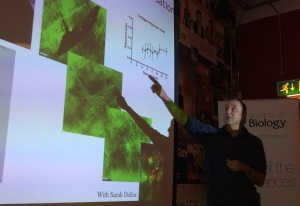
In wound healing, the biggest difficulty in the past has been the ability to visualise a skin wound to view the re-growth of epithelium and the effect on blood vessels. The inflammatory reaction to the wound stimulates fibroblasts to lay down a collagenous scar, which acts as a physical barrier but can disable tissue function. Interestingly, embryos in the first two trimesters do not produce scaring following tissue damage as the inflammatory response does not develop until the end of the 2nd trimester.
Due to their transparency, Zebrafish and the use of fluorescently tagged immune cells have been used to visualise the immune response, and Professor Martin showed us some amazing videos of macrophages migrating to the site of a wound. The same lab has also generated a fish with “green” collagen which shows the creation of the collagen mat, which fills the damaged area and results in scarring.
One of the effects of macrophages at the site of a wound is to promote cells’ resistance to apoptosis, which might otherwise occur due to cell damage. In this regard, tumours have similar characteristics to wounds, and thus a study of wounds could lead to a better understanding of tumours and their treatment.
As an aside, Professor Martin mentioned why low dose aspirin appears to protect against colorectal cancer due it its interference in the inflammatory response.
Neutrophils help cancer cells to grow at the fringe of a wound and thus a biopsy of a tumour (which is a wound and will draw in inflammatory cells to the biopsy site) can facilitate further cancer growth. This was confirmed by the retrospective review of 30 years of Danish data of patients who were known to have chronic wound ulcers associated with their melanoma cancers.
So, in conclusion, studying the mechanism of wound healing will help us to better understand the process of scarring and might also help us to better understand cancer and so help guide us towards better medicines for both of these conditions.
Christopher Bailey FRSB
Christmas Social and visit to the Wildlife Photographer of the Year Exhibition
6 December 2016
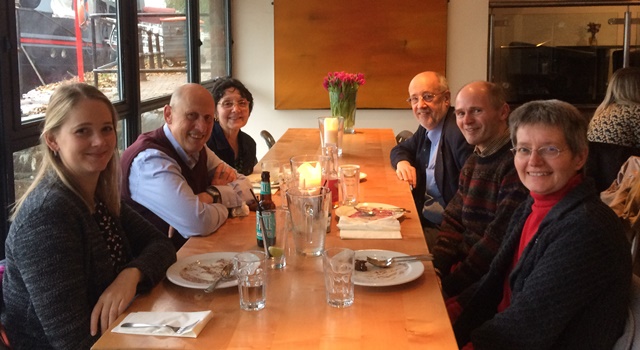 This year the Western branch tried a different festive get together by having lunch at the Riverstation in Bristol followed by an optional trip to see the Wildlife Photographer of the Year show at the nearby M Shed museum. Whilst numbers were low, we all had an enjoyable natter over biological and non biological topics. As we all had other commitments that afternoon, no one went onto the M Shed photography exhibition but Catherine did later visit the exhibition in London the following weekend.
This year the Western branch tried a different festive get together by having lunch at the Riverstation in Bristol followed by an optional trip to see the Wildlife Photographer of the Year show at the nearby M Shed museum. Whilst numbers were low, we all had an enjoyable natter over biological and non biological topics. As we all had other commitments that afternoon, no one went onto the M Shed photography exhibition but Catherine did later visit the exhibition in London the following weekend.
Christopher Bailey FRSB
The National Arboretum
10 December 2015
On a cold and wet December day nine hardy souls turned out for our annual Christmas get together, this time for a walk around the Westonbirt arboretum instead of our usual sit-down lunch.
Our guide for the afternoon was David Swinson, a retired GP who was one of a number of volunteer guides at the arboretum.
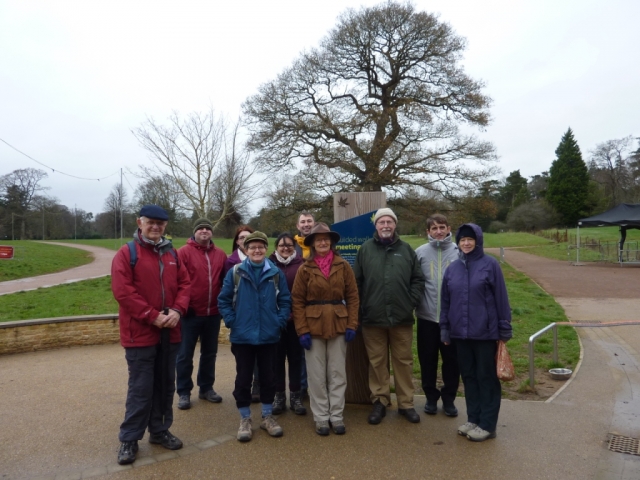
The gardens were created by the wealthy Holford family who had made their money in banking. The old family house is now a girl's school whilst the arboretum was given into the care of the Forestry commission in 1956. Within the arboretum are a number of champion trees, noted for their size, and the first we came across was an example of Armani birch.
A number of Wellingtonias were encountered too which are among the oldest tree species in the world. There are three main types – giant redwood (wellingtonia), coastal redwood and dawn redwood. Next we came across the oriental plane of which there are three groups: oriental (Greece), the London plane and the American plane. In the US the planes grow to a great height but in the EU they are much more stunted.
As an aside David told us the big house the Holfords built had 60 bedrooms and used hydraulics to power lifts and a fire sprinkler system. The arboretum was set out by Robert Holford in 1840s and further developed by his son George. By 1926 George Holford had died and the Mowsley family took over and having no interest in the house gave it to an educational trust whilst they retained the arboretum. As with many great landowners, the Holfords moved the main road when creating the arboretum to improve the view and also moved the local village.
The arboretum is experimenting with species from other hemispheres to find trees more adapted for the EU due to global warming. Hence species from New Zealand and Australia like the celery topped pine (Phyllocladus aspleniifolius) can be found here.
Other species being tried include Coprosma propinqua, which has very dense foliage and fruit that smells like dog poo, and Podocarpus salignus, an evergreen from Chile which grows well in New Zealand and is used for canoes due to the high resin content.
After about two hours we returned to the comfort of the tea room for some welcome warm drinks and cakes and had a pleasant natter on topics biological and not so biological.
Christopher Bailey FRSB
The story of polio
10 February 2015
Members gathered for an evening talk on polio by Gareth Williams, emeritus professor of medicine and senior research fellow in philosophy at Bristol University. Gareth opened by saying polio had been extinct in his time as a practising physician, with the last outbreak being in 1952.
Usually poor hygiene was the cause of outbreaks, with nothing more than an upset tummy as the virus passed through the gut. However in a small percentage of cases, the virus would breach the intestinal barriers and get into the blood stream, and hence onto the nervous system, where the main side effects of the disease are manifest. The virus destroys motor neurones and depending which ones it attacks, leads to various degrees of paralysis.
A small outbreak was noted in 1780, and by 1840 it was becoming more prevalent – an increasing number of children were seen with paralysis of the limbs. It is quite possible the virus had mutated around this time from a rare and sporadic disease to an epidemic type – possibly due to an improvement in sanitation.
As always various treatments had been tried – leeches in 1850, red hot pokers in 1870, electric shocks in 1900, 'brain washout' in 1935 (by draining fluid at the base of skull), vitamin C in the 1950s and cobra venom in 1960s.
By 1953 fatalities caused by polio was second only to those caused by war. Jonas Salk introduced an injectable vaccine in 1955 which was improved by an oral form in 1963 by Albert Sabin. The Salk vaccine was an attenuated form of the virus with enough viral protein to induce immunity.
Salk tested his vaccine on 1.8 million children in 1954 – one of the biggest clinical trials of all time and although there were few in the control group, there was just enough to statistically prove the efficacy and safety of the vaccine. In fact, some trial patients did go on to develop polio but this was traced to poor manufacturing controls.
In 1988 the Who/Gates foundation announced the aim to eliminate the disease by the year 2000, and by 1998 it had been eradicated from the USA and most of the EU and Russia.
By 2000 only 400,000 cases were reported worldwide. In 2001, just a few cases were left in Africa and by 2012 only around 200 cases in Chad, Afghanistan and Pakistan. However due to war in those regions it has risen again with 450 cases in Syria and Israel. Some of this is down to difficult geography, but also religions who oppose western technology. Eradicating polio completely will remain difficult while certain groups view western treatments with suspicion.
Christopher Bailey MRSB
AGM
18 November 2014
The Western branch held its AGM at the end of November at The Tobacco Factory in Bristol. The meeting started with a lecture by Professor Bruce Hood FRSB (director of the Cognitive Centre at Bristol University) on his new book, The Domesticated Brain. Bruce presented contemporary thinking in neuropsychology that links structural and physiological changes that have been observed over time in the brains of humans and animals with the inherently social nature of humans and domesticated animals. After an interesting talk a lively discussion arose during the ensuing question session.
The AGM saw the retirement of long serving committee member Gerald Coles FRSB from the committee. On behalf of the Western branch, the new committee would like to thank Gerald for his sterling work and long standing commitment to the branch. He will be missed on the committee but we're sure we'll see him at branch events in the future.
A new committee was elected with Michael Graz FRSB maintaining his role as chairman, Roger Symes MRSB maintaining his role as treasurer and Andrew Newby FRSB taking on the role of secretary. Chris Bailey MRSB maintained his role as a committee member. The committee would like to encourage any members of the society to contact us if they would like to join us to create a vibrant branch in the West.
Michael Graz CBiol FRSB
Where Will Our Food Come From?
16 October 2014
The words engaging, interesting, inspiring and thought provoking were overheard describing the debate that followed this lecture on future sources of food.
Experts in nutrition (Worcester University), climate change (Bristol University), farming practices (Soil Association), water resource management and food distribution (the Royal Agricultural University), and local and international community based food production and awareness programmes (the Food for Life Partnership and Tree Aid) shared a wealth of first-hand expertise to lay the fascinating groundwork for an interactive discussion.
Challenges, contradictions and opportunities in food production, transport, storage and equity of access to calories were highlighted. The ethical and practical pros and cons of food enhancement using scientific methodologies proved to be a source of lively debate. After two hours, and with much discussion still to be had, proceedings were called to a close. Roll on the follow-on discussion.
Heather Graz ASMB
The Jenner Museum
21 June 2014
On a fine summer day, we visited the Jenner museum, Gloucestershire, where Dr Tim Wallington, chairman of the trust, introduced us to Jenner, the man.
Edward Jenners' ancestors were originally bakers but by his father's time were wealthy landowners. Edward was the 8th of 9 children and, while his brothers studied theology at Oxford University, was more interested in fossils and natural history.
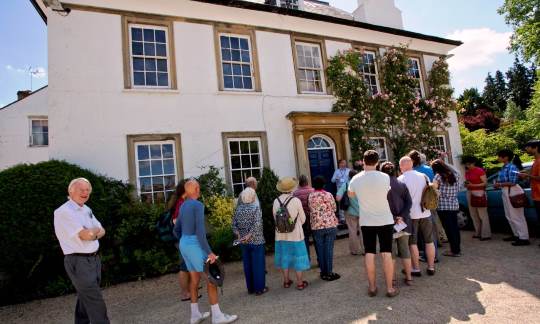
He was variolated (an early form of inoculation) in 1757 whilst at school at Wotton-Under-Edge and it was an experience he would never forget. It involved four weeks of bleeding, purging, a meagre diet and then exposure to smallpox, but at least only one in 50 died compared to one in five if caught naturally.
Edward had noted on travels around his rural medical practice in Berkeley that cowmaids didn't catch smallpox. Years later Jenner conducted one of the first clinical studies by vaccinating James Phipps, a "willing" 8 year old volunteer with cowpox. After exposing the boy to smallpox – the disease did not develop.
His paper to the Royal Society was rejected, so after two more years and further subjects he published at his own expense in 1798 his research into smallpox. The rest, as they say, is history and in 1980 the World Health Organisation declared that smallpox had been eradicated.
As for Jenner, he may be famous for smallpox vaccination but he received his fellowship of the Royal Society for his work on the cuckoo.
Christopher Bailey CBiol MSB
AGM
31 October 2013
Our AGM has long past but saw the retirement of both the long serving chairman, Mark Howard, as well as the ever-present secretary Joan Ashley. On behalf of the Western branch, the new committee want to thank both Mark and Joan for their sterling work and long standing commitment to the branch.
A new committee was elected with Michael Graz FSB becoming the new chairman, Roger Symes MSB maintaining his role as treasurer and Gerald Coles FSB and Chris Bailey MSB maintaining their roles as committee members. Professor Andrew Newby FSB was newly elected as a committee member. The committee is looking for extra members that would like to shape the future of the Western branch. Please get in contact if you are interested.
In 2014 we are planning to arrange more field-based events including guided bird watching walks, a visit to the Jenner museum, some topical lectures (possibly in conjunction with other societies) and we're also hoping to hold a mushroom hunting trip during Biology Week. If there are any mycologists out there, who could help us lead this trip please get in touch.
Dr Michael Graz CBiol FSB
Cracking and fracking
19 March 2013
Andrew Newbym FSB British Heart Foundation professor of vascular cell biology at the University of Bristol described his research into how plaques attach inside arteries and the consequences of failure. The plaque is a type of tissue; an atheroma sealed in with a layer of sclerosis. If the sclerotic cover breaks the contact of blood and atheroma initiates coagulation. Andrew and his colleagues' have found that weakness is caused by foam cell macrophages breaking down collagen in the structure. Unattached plaques can lead to a blood clot, blocking the artery and bringing on the life threatening heart attack - which obviously affects the whole organism.
Going from this tissue level view to a cellular level has revealed that the balance of metalloproteinases and their inhibitors seems to determine if the collagen is excessively broken down. At the level of the DNA that balance is produced by activation or inactivation of certain units. The outcome of the research for the whole organism (you and me) is the possibility of a drug or other way of adjusting these balances. This could stabilise plaques, reduce clots and prevent some heart attacks.
Dr Tom Johnson consultant cardiologist at Bristol Heart Institute spoke about new technology transforming the visualisation of artery blockages. Two high-tech devices using intra-vascular ultra-sound and near infra-red spectroscopy can be used to get remarkable views of arteries. They have to be inserted in the patient however the information is more precise than from external techniques. The resolution of the devices enables you to see the phenomenon of macrophage weakening. This means that it would be possible to spot trouble before disaster arrives.
Even with this research and new technology the speakers reminded everyone that basic whole organism behaviour was important! Avoid being overweight, be thoughtful about diet and exercise and look out for common symptoms.
Mark Howard CBiol MSB and Joan Ashley CBiol MSB
Starling roost spectacular and reserve walk
7 February 2013
Despite the cold members enjoyed a walk through the RSPB Ham Wall Reserve at Meare. Mike Johnson, former assistant warden at the reserve, identified everything that flew past. He guided the party through the reserve and recounted the history of its development and management.
Starlings frequently roost during the winter months at Ham Wall but of course when members visited they had decamped to the nearby Shapwick Heath National Nature Reserve. Near dusk Mike took the party to the nearest vantage point and we waited and waited. Then the first cloud became apparent, followed by many, many, more coming from all directions.
It is thought that around 2 million starlings arrive in the area to roost in the reed beds. In days gone by there were estimated to have been up to 6 million. Although it was not great weather for photography it was a successful field meeting with spectacular sights.
Roger Symes CBiol MSB
Omega-3 Fatty Acids Lecture & Social
13 December 2012
Omega-3 fatty acids were the topic of our Christmas lecture. Dr John Tarlton, from the University of Bristol, spoke with passion about their history and present use. Found in cold water fish and green leafy plants, these compounds are involved in many biochemical processes. John described how they are metabolised and why a lack of them in the diet can affect various animals. The negative effects on brain development and bone strength were two areas of interest.
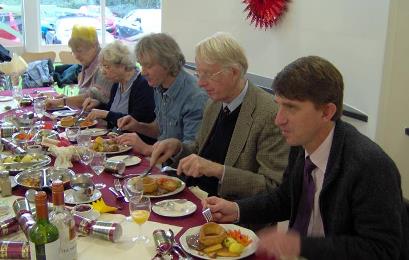
The audience reflected on the idea that fish eating probably affected early humans and their mental evolution.
With modern fish stocks in crisis, can we maintain omega-3 supplies for future generations? A number of alternatives are available though some are more satisfactory than others.
Members also enjoyed a fine meal at the University of Bristol Vet School. A branch member said afterwards it was "a very satisfying lunch and lecture" and several members made resolutions to add omega-3 containing foods to their New Year shopping!
More on John's work is available on the University of Bristol website.


